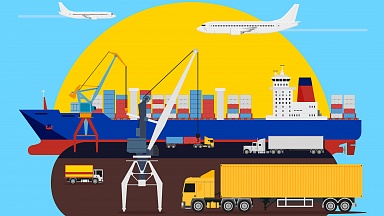The latest weekly and monthly data for October from leading industry analysts CLIVE Data Services and TAC Index shows a week-on-week decline of 3% in the last week of October, including a 5% drop in China-Europe tonnages, although the average tonnages for the last four weeks of October were 3% higher relative to the last four weeks of September.
And according to figures from WorldACD, worldwide chargeable weight in that same last week in October (week 44) decreased by 1% compared with a week earlier, with Asia Pacific the only origin region with a slight increase in chargeable weight (+1%).
WorldACD’s figures indicate that worldwide capacity in week 44 was down by 2% compared with the previous week, with the only increase in capacity coming from the Middle East & South Asia (+1%) region, with the largest decrease in capacity being from North America (-4%). Worldwide yield/rate (in US$ per kg) increased for the third week in a row.
CLIVE Data Services and TAC Index highlighted that the broader trend appears to remain positive, with the data for October showing «a sustained improvement in volumes and rates, and a record ‘dynamic load factor’ — based on both the volume and weight perspectives of cargo flown and capacity available — of 72% in the week of 19-25 October». This further reduced the year-on-year decline in volumes to just −13% versus October 2019 from a peak of −37% at the start of Q2 2020, the analysts said.
«However, the 3% month-on-month growth in volumes for the last four weeks of October, and double-digit rate increases year-on-year, may start to level out if consumer concerns over public health and job security result in them ‘keeping their wallets closed’ and lower demand for air cargo capacity,» the two organisations highlighted.
The two analysts noted that airlines are continuing to flex cargo capacity in accordance with demand — and to compensate for the dramatic loss of passenger traffic. Westbound capacity from China reflected this with a double-digit reduction in the last week of October, meaning capacity remained tight from China to Europe and, despite the 5% fall in volumes, prices remained elevated, added Robert Frei, Business Development Director at TAC Index.
«Air freight prices for China/Hong Kong-EU increased 9% week-over-week in the last week of October and were 25% higher than in the final week of September,» Frei noted. «In absolute terms, rate levels were 60% up compared to the previous 2020 high in May. This is also true for China/Hong Kong-US traffic, where rates for the last week of October were up 28% over the same seven days of the previous month. Clearly, the industry will be monitoring the demand cycle very closely as we potentially enter into another period of uncertainty,» he said.
Nevertheless, Niall van de Wouw, Managing Director of CLIVE Data Services, told Lloyd’s Loading List that despite the upward trend on a monthly level, October did not end on a high.
He noted: «At a high level, the air cargo market can look at October’s performance data and feel reassured the recovery back to pre-Covid levels is continuing. However, there will also be some companies looking over their shoulders at the 3% drop in demand in the last week of the month and wondering if the uncertainties caused by the second wave of the virus are about to stop that recovery in its tracks.
«We will know more once we see the November numbers but the 1.5% drop in the dynamic load factor in the usually strong last week of the month is unusual and raises question marks over demand in the coming weeks.»
He continued: «What we may be seeing is a fall in demand at the end of last month which coincides with government lockdown measures in some countries to curb the second wave of coronavirus. While the dynamic load factor and airfreight rates for the month were higher, this was less built upon demand and more upon low supply, with the −26% annual decline in capacity.
«Perhaps this final week of October indicates that the peak might not be as strong as the industry had envisaged and hoped for.»
Offering a freight forwarder’s perspective, in its latest weekly Air Freight Market Update on 3 November, Flexport noted that the situation in Europe remained «similar to previous weeks», with the far east westbound (FEWB) market «significantly under pressure, and rates continue to climb week by week». It highlighted that delays in transit and as well on the ground needed to be taken into consideration when planning transit times. And it also highlighted tight capacity on the transatlantic westbound route (TAWB) and rates remain at high levels.
For the Americas, it noted that the transatlantic eastbound (TAEB) market «remains balanced between demand and offered capacity, with no big spikes. Load factors from LAX/ORD/JFK to central European hubs remain high.»
Meanwhile, the transpacific westbound (TPWB) market «remains under pressure in terms of yield, as capacity still outpaces demand, especially to HKG/PVG/ICN».
It said LATAM trades «are seeing spikes of demand. The Northbound trade has increased output of perishables and the Southbound trade has increased Exports from the US and transit cargo, while still suffering from a capacity crunch».
And in the latest international freight update on 4 November, Freightos noted that «peak season is still hitting air cargo, with rates still climbing», with the organisation’s marketplace data showing «a 4-9% rate increase on most lanes out of China» since the previous week.
It also noted that import rates for Amazon sellers from Asia to US Fulfilled By Amazon (FBA) centres also climbed, with air rates up 34% since last week, and 92% since the start of October.





